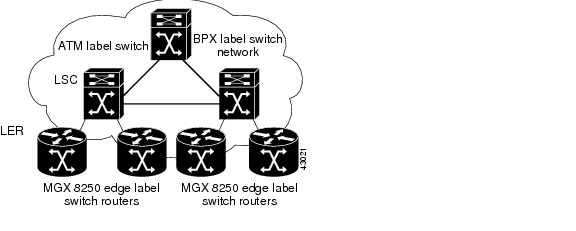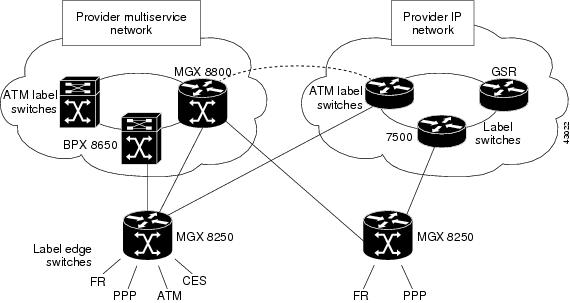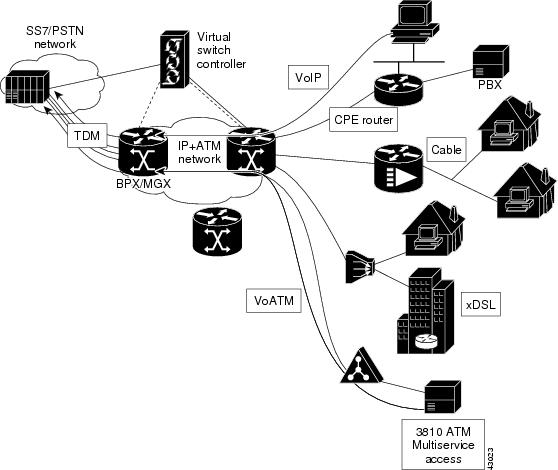

Table Of Contents
Multiservice Standalone Switch
Consolidation of Cisco CPE Traffic
Multiservice Stand-Alone Concentrator
System Overview
Introduction
The Cisco MGX 8250 wide-area edge switch is a carrier-class edge concentrator that integrates multiple services and service management capabilities on a single platform. The MGX 8250 cost-effectively delivers Frame Relay, circuit emulation, ATM cell relay service, IP VPNs, and voice (VoIP, VoATM) at high volume and with high scalability—from DS0 to OC-12c/STM-4 speeds.
The MGX 8250 chassis accommodates from DS0 narrowband interfaces with port density scaling to more than 1000 DS1s interfaces.
The MGX 8250 supports both Layer 2 and Layer 3 services in the same edge concentrator.
Services include:
•
IP VPNs using Cisco IOS software-based MPLS/label switching.
•
Full suite of Voice-over-IP, Voice-over-ATM, and capabilities with full interworking.
•
Frame Relay services.
•
High-density Point-to-Point Protocol (PPP) for Internet access and aggregation.
•
Narrowband ATM for managed data, voice, and video services.
•
Circuit emulation (CE) for private line replacement.
The MGX 8250 platform can also support a wide range of services over narrowband and midband user interfaces, mapping all the service traffic to and from ATM, based on standardized interworking methods.
The MGX 8250 switches support up to 192 channelized or unchannelized T1 and E1 interfaces on a single switch. These interfaces provide support for:
•
Frame Relay UNI and NNI
•
ATM UNI, NNI, and FUNI
•
Frame Relay-to-ATM network interworking
•
Frame Relay-to-ATM service interworking
Multiple T1 interfaces can be supported on physical T3 lines using the service resource module (SRM). Frame-based services on T3 and E3 high-speed lines are also supported. The MGX 8250 switches also support the use of inverse multiplexing for ATM (IMA) to provide ATM trunking below T3/E3.
MGX 8250 Example Applications
The MGX 8250 edge concentrator is a multiservice, carrier-class platform that aggregates IP,
Frame Relay, ATM, voice, and private lines at the edge of the network. This section summarizes the following example applications:•
Multiservice Standalone Switch.
•
Multiprotocol Label Switching.
•
Consolidation of Cisco CPE Traffic.
•
Multiservice Stand-Alone Concentrator.
Feeder to the BPX Networks
The MGX 8250 supports the networking protocols required for integration into an existing BPX network, specifically, as a feeder to a BPX 8600 series service node.
Because the MGX 8250 supports multiple services on a single platform, carriers can customize deployments across diverse point-of-presence (PoP) while maintaining common inventory and operations support.
Figure 1-1 MGX 8250 as a Feeder to the BPX Backbone Networks
When configured as a feeder to the BPX networks, the MGX 8250 has the following enhancements:
•
Support for an OC-12c/STM-4 feeder trunk to the BPX 8600 series. This feature allows greater aggregate traffic capacity to be fed to the BPX 8600 series core switching shelf.
•
Local switching between ports. MGX 8250 feeders can be located remotely from the BPX and perform local switching without consuming bandwidth on either the feeder trunk or the BPX connection counts.
•
Support for SONET/SDH 1+1 automatic protection switching (APS) on both the OC-3c/STM-1 and OC-12c/STM-4 interfaces. With APS, the feeder trunk is also protected against fiber cuts with 50 ms switchovers. This feature is particularly important for remote feeder applications.
Multiservice Standalone Switch
The MGX 8250 can be deployed as a stand-alone switch, providing "cross-connect" connections between UNI and NNI ports. Traditionally, this capability would be used in a concentration-type mode, allowing standards-based adaptation and concentration of multiservice traffic onto one or more high-speed ATM interfaces. The MGX 8250, therefore, can interface to a multivendor ATM network, or to any other ATM attached device (for example,a Cisco 7200, GSR router LS1010 or MSR 8450).
A standard ATM UNI or NNI connection is used to interface with the ATM equipment.
Multiprotocol Label Switching
The MGX 8250 is well suited as an edge device in an Multiprotocol Label Switching (MPLS) network. The MGX 8250 can act as an edge label switch router for support of IP traffic. At the same time, the MGX 8250 can support Layer 2 services as a BPX feeder or as a multiservice stand-alone switch.
As a component of the BPX 8680 IP universal service node, the MGX 8250 is capable of forwarding traffic into the BPX MPLS network by acting as a multiservice feeder and supporting up to 12 edge label switch routers in a single chassis.
The MGX 8250 can also be used to aggregate and separate the IP traffic onto a pure IP backbone, distinct from the ATM backbone that it uses for Layer 2 services.
Figure 1-2 MGX 8250 Label Edge Routing
As a label switch or a label edge router, the MGX 8250 can interface to a multiservice IP+ATM network consisting of BPX and/or MGX 8250 label switches. The MGX 8250 can also interface to a pure IP backbone such as the one depicted in Figure 1-3.
Figure 1-3 MGX 8250 Edge Switch Multiservice Label Feeder Evolution
Consolidation of Cisco CPE Traffic
At the edge of the network, the MGX 8250 can interwork with and consolidate a wide variety of CPE equipment such as ATM, Frame Relay, and voice (both Cisco and multivendor). See Figure 1-4.
Cisco provides the following combination of products that allow service providers to focus their training and operations on a single vendor for all services:
•
End-to-end management applications for all platforms (CiscoView).
•
End-to-end service activation (WAN service agent).
•
Value-added Cisco IOS features.
Figure 1-4 Consolidation of CPE Services
Multiservice Stand-Alone Concentrator
The MGX 8250 can be deployed as a stand-alone concentrator, interfacing to a multivendor ATM (non BPX) network using standard ATM UNI or NNI interfaces (see Figure 1-5).
•
MGX 8250 supports ATM UNI and NNI service for PVCs. The switch is deployed in situations where other ATM equipment has already been deployed and where an MGX 8250 provides a front end as a multiservice concentration device.
•
ATM UNI port can be supported at the PXM uplink to eliminate the need for a separate ATM trunking card.
•
MGX 8250 also supports local switching between service modules and PXM ports.
Figure 1-5 MGX 8250 Edge Switch as a Stand-alone Concentrator
Connection Types
There are three basic types of connections. See Figure 1-6.
1.
DAX connection—Both connection end-points are located on the same MGX 8250 chassis. This connection has two halves where one is master and one is slave.
2.
Two-segment connection—A two-segment connection is defined between an MGX 8250 feeder node to a BPX line port.
3.
Three-segment connection—A three-segment connection is defined between an MGX 8250 feeder through the BPX trunks to another MGX 8250 feeder.
Figure 1-6 Overview of Connection Types
Note
In the above diagrams, the SM box refers to either a service module card (such as the FRSM or the CESM) or the RPM.

 Feedback
Feedback





